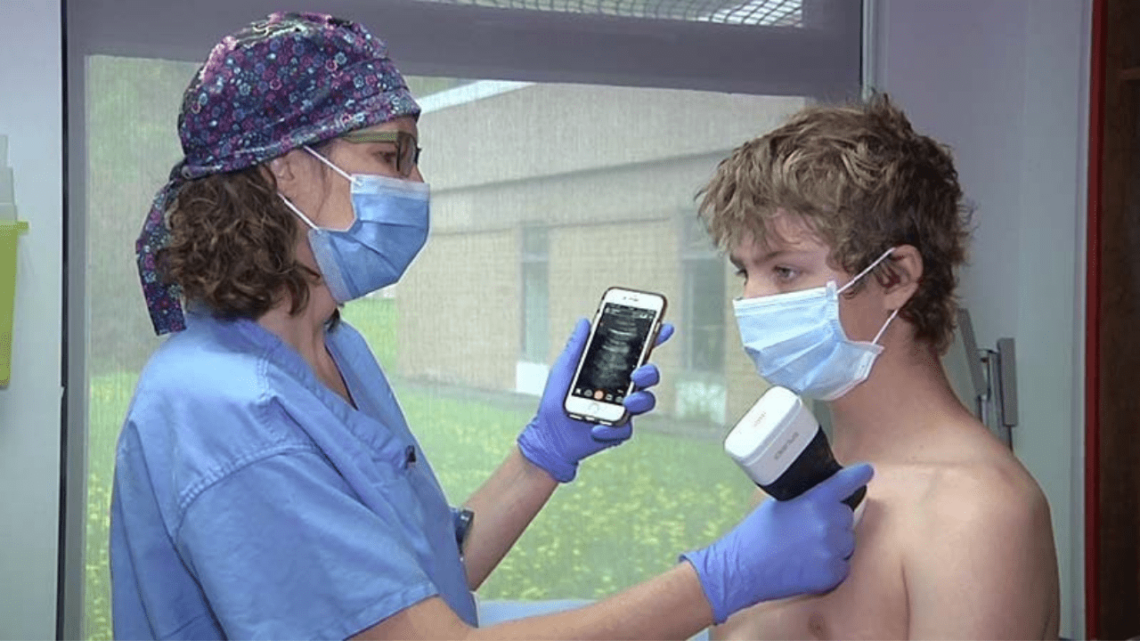Ultrasound is an essential clinical tool that can provide early diagnosis of many medical conditions, from heart conditions and pre-natal risks to identifying lung abnormalities that may indicate the presence of COVID-19. Traditional ultrasound devices are large, bulky machines found mostly in large urban health centers. Citizens in remote or rural communities need to travel sometimes hundreds of kilometers to access this critical health service.
The Point-of-Care Ultrasound project has revolutionized access to ultrasound by developing handheld ultrasound devices powered by artificial intelligence. This means that citizens in Nelson, Haida Gwaii and other remote and indigenous communities in BC now have access to ultrasound.
“The portable scanners have become a critical part of my toolbox,” shares Dr. Jennifer Kask, a family physician with North Island Hospital, who’s been able to see and treat multiple women in communities such as Campbell River and Port Hardy. “I love it. I take it everywhere with me, just like I take my stethoscope and pen to the office every day,” she adds.
When COVID-19 hit, the project team immediately considered the potential to expand the application of the handheld ultrasound devices to focus on identifying lungs potentially compromised by COVID-19. The team pivoted quickly and the Point-of-Care Ultrasound (POCUS) for COVID-19 project came to life.
With impressive speed, project members Providence Health Care (Project Lead), Change Healthcare, Clarius Mobile Health, the University of British Columbia, St. Paul’s Foundation, and the Rural Coordination Centre of B.C. (RCCBC) joined forces to deploy more than 80 Clarius portable handheld ultrasound scanners in remote communities and long-term care homes across the province.
“Ultrasound has been a game-changer for rural care in general, allowing immediate diagnoses for triaging and expediting trauma cases to higher levels of care,” explains Dr. Virginia Robinson of the Rural Coordination Centre. “The establishment of the COVID network means physicians have been able to share their images with any specialist and receive immediate feedback.”
Dr. Robinson says the Supercluster has generated “a cooperative intelligence” that she describes as the ability for its members to leverage each other’s diverse areas of expertise to develop new technologies that improve patient care.
In rural and Indigenous communities that lack specialty care, and face challenges in getting timely diagnosis, the POCUS project is having the biggest impact, Dr. Robinson says. “Some of our most rural communities are Indigenous, and therefore, they’re now benefiting. Physicians can use these portable ultrasound devices to distinguish between small issues and emergencies, and this can save lives.” Over the last four months, 52 probes have been deployed in 32 rural communities, including 12 Indigenous communities.
The tool is also saving money. Transferring a patient from a rural setting to a city for urgent diagnostic imaging costs up to $20,000, while patients are also out of pocket when they travel for non-urgent care. “For patients, physicians and the healthcare system, this is an incredible development,” says Dr. Robinson.
In addition, POCUS is allowing physicians to treat underserved communities and underrepresented groups that may not have traditionally showed up at the hospital or the clinic. “Our ability to reach people who might not present themselves otherwise is also really beneficial,” Dr. Robinson explains.
The POCUS project is also positioning B.C. and Canada as leaders in healthcare education through the use of handheld ultrasound devices. “Ultrasound has been around for a while, including some portable ultrasound, but B.C.’s approach in creating a system and community of practice where we can share and learn from each other is going to elevate us and ensure long-term benefits,” says Dr. Robinson.
Learn more about the POCUS COVID-19 project here
